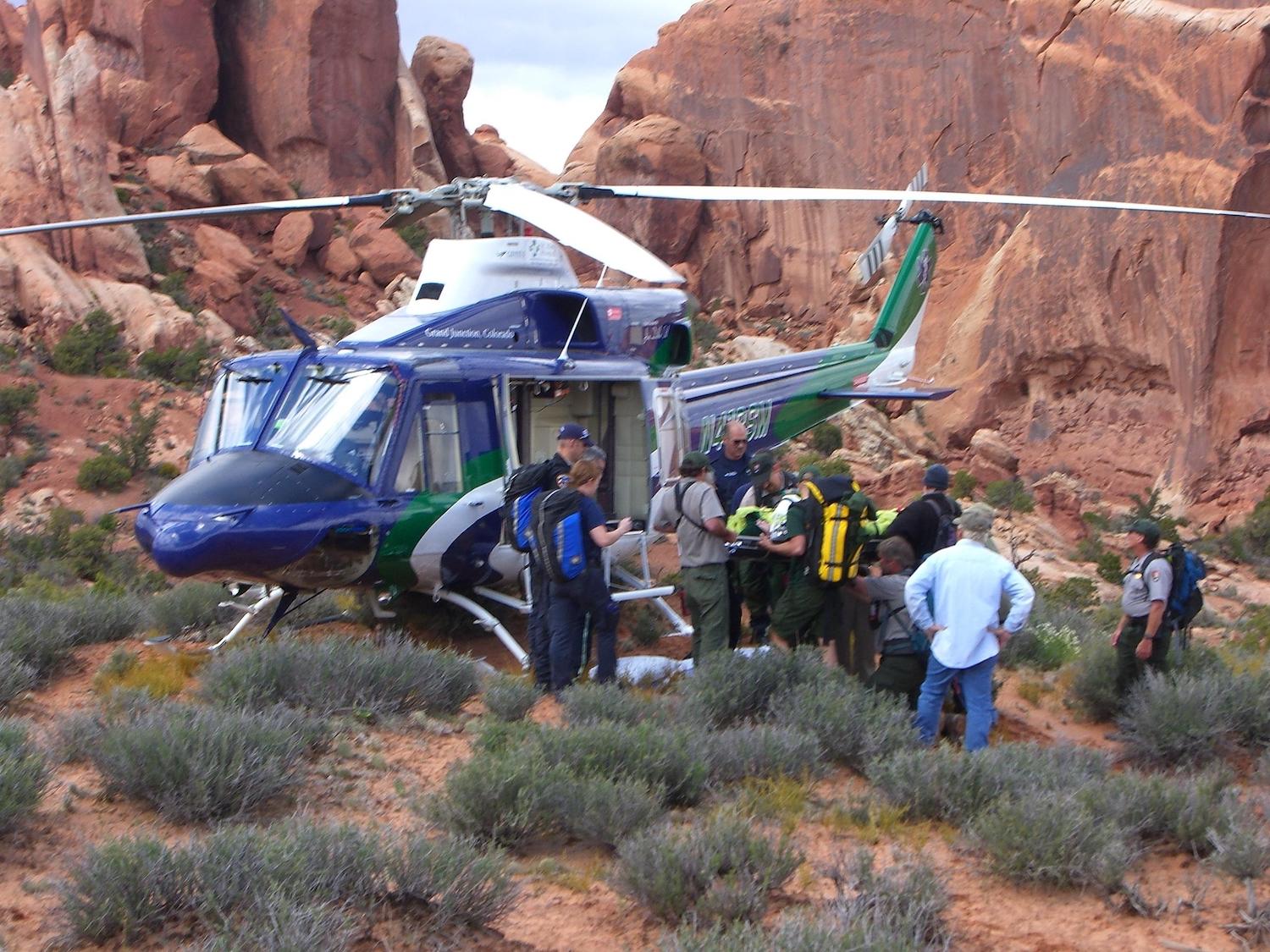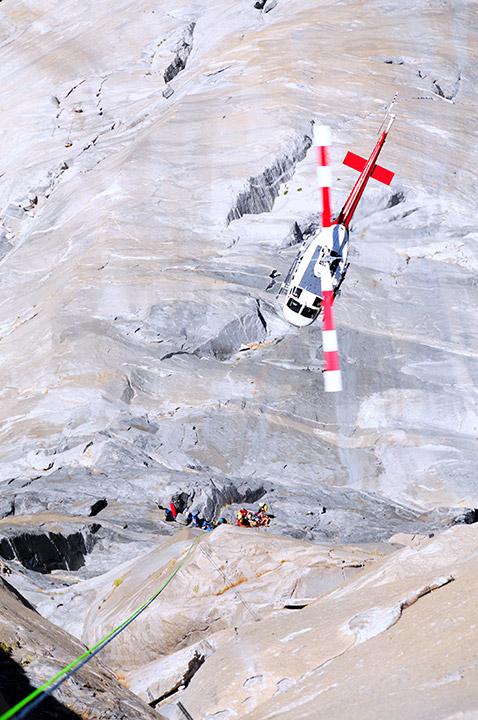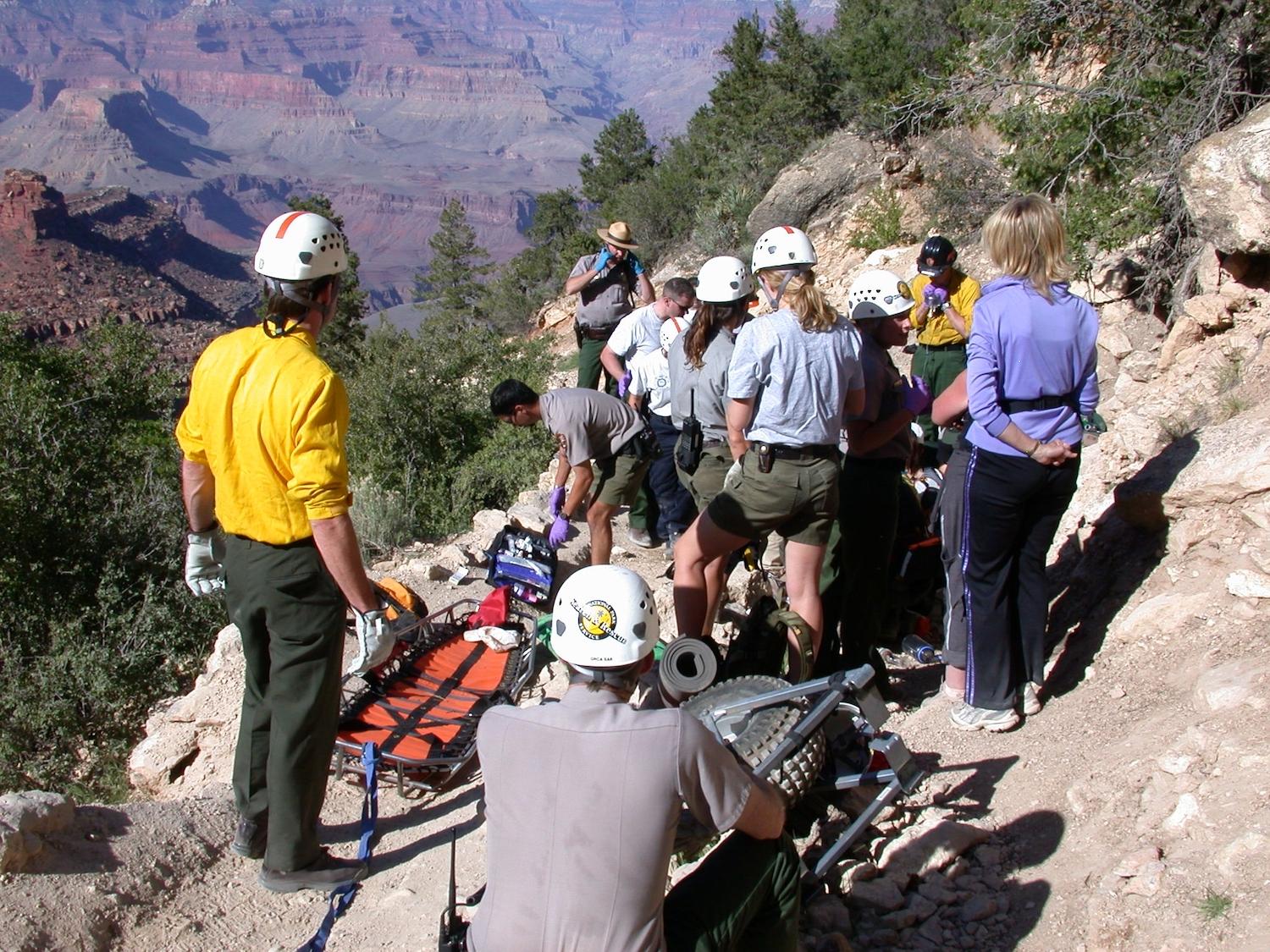
Some rescues require helicopters to evacuate the injured from backcountry ares, search as this SAR mission in 2011 at El Malpais National Monument/NPS
Search-And-Rescue Missions Growing In National Park System
By Lori Sonken
When two New Yorkers sightseeing in Alaska departed a Talkeetna airfield not far from Denali National Park on a beautiful late May day, there was a clear morning sky perfect for their Cessna 182. They had no idea what was in store for them.
Despite the initial clear weather, several hours later they encountered turbulence and a downdraft caused their aircraft to crash onto a plateau that jutted out from the mountains just inside Wrangell-St. Elias National Park and Preserve near Mount Hawkins.
“It was death. We were dying,” said Frederick Northup, the sole passenger in the aircraft piloted by James Feola.
The plane ruptured and the impact scattered their gear and emergency supplies, leaving only a four-season mountaineering tent and some granola bars accessible. The tent kept them from freezing -– the temperature was in the 30s – but it was the Garmin InReach satellite communication device next to Northup’s leg that likely saved their lives.
With the push of an SOS button, Northrup was able to summon help.
Numbers Of Search-And-Rescue Missions Climbing
Across the country, search-and-rescue missions (SARs) at national parks are up this year. From January to June there were 1,470 incidents, slightly more than the 1,403 reported during the same months in 2018, said Cynthia Hernandez, a National Park Service spokesperson in Washington, D.C.
But the numbers are starker at some individual parks, such as Acadia National Park in Maine, where year-to-date SARs through mid-August were up 65 percent compared to the same period for 2019.
There are preventative actions visitors can take, including carrying proper gear – such as the satellite communicator Northup’s wife, Anne, bought for his trip -- to reduce risks and keep outcomes positive.
“Everyone should have one. They are not that expensive,” Northup said. The phones range in price from $350 to $600, in addition to subscription fees.

Parks such as Yosemite can present more challenging situations for rescue missions/NPS file
Northup pushed the SOS button and sent a “rescue needed” text message via Garmin, one of several providers of satellite messaging devices. This triggered a call to the International Emergency Response Coordination Center, which in turn notified the NPS Alaska Regional Communication Center. Garmin also alerted Northup’s daughter in upstate New York that her father was in trouble.
“It was awful for us, and I imagine even worse for them. We didn’t sleep. We just sat in the living room waiting and waiting,” said his daughter, Sara Northup-Lynch, in an email.
Thirty-six hours later, after several failed attempts by different search-and-rescue crews struggling against low visibility, high winds, and snowfall, a rescue team aboard an Alaska Air National Guard Pave Hawk helicopter rescued the men around 2 a.m. on Memorial Day, May 31, two days after they were stranded on the mountaintop.
Fortunately for Northup and his pilot Feola, there were search-and-rescue teams already in the area looking for 12 stranded mountaineers near Mount Bona. Once plucked off the mountain the two were transported to a regional medical facility in Anchorage, where Northrup was treated for a sprained foot.
The May plane crash at Wrangell-St. Elias is one of six SAR operations this year, including three fatalities, in the vast park and preserve equivalent in size to Yellowstone, Yosemite, and Switzerland combined. This year’s SAR numbers are comparable to 2018, yet there are an estimated 30,000 fewer people visiting this year than three years ago, said Carrie Wittmer, a public affairs officer for Wrangell-St. Elias.
Individual Parks Have Seen SARs Increase
Other parks, including Grand Canyon, also are witnessing an increase in SAR operations despite a drop in visitation.
“Our number of SAR calls is up about 25 percent despite the park’s visitation being down by about this much,” said Meghan Smith, preventive search-and-rescue supervisor, in an email. Park visitation levels at Grand Canyon are lower, likely due to international travelers not visiting the United States during the pandemic, she said.
Smith hypothesizes one reason for the increase in SAR incidents is that people’s fitness levels declined during the pandemic. Their daily routine no longer includes walking upstairs, across parking lots, or in large office buildings, as they may have done pre-pandemic. Additionally, there are fewer commercial bus tours operating, so more visitors are hiking the trails instead of riding in a bus.
“We commonly respond to heat-related emergencies, general fatigue (often due to poor fitness), inability to complete their planned itinerary (often due to fitness and poor planning), lack of supplies (due to poor planning) along with orthopedic injuries and pre-existing health conditions,” she said in an email.
Despite visitation numbers being down this year at Grand Canyon and Wrangell-St. Elias, overall recreation visits are increasing throughout most of the system, said NPS spokesperson Hernandez.
In general, rescuees are not charged for SAR operations on federal lands. However, if a park’s aircraft is unavailable and mutual aid is requested from another source, those rescued likely will be responsible for all charges, Smith said. The costs vary depending on the type of emergency, the location, time of day and available resources, but can cost multi-thousands of dollars.
Flash Flooding At Zion
A popular walk in Zion National Park's iconic slot canyon -- The Narrows -- winds through a gorge that narrows to 20 feet wide in places with walls at times soaring as much as 2,000 feet high. Along the floor runs the Virgin River, a usually placid stream that can flood in a flash when thunderstorms pelt the park with a deluge.
Visitors have the option of hiking along the paved Riverside Walk that goes a short way into the section of canyon, or traveling farther upstream through the Virgin River on uneven and slippery boulders.
“People don’t take walking The Narrows seriously,” said Makalya Lamb Ramirez, a Bellingham, Wash., resident with firsthand experience of the walk’s challenges.
On July 23, she was crossing the Virgin River with her boyfriend and two cousins – all in their 20s. Suddenly, a flash flood sent muddy water storming down the river.
“Where the water was ankle-deep, suddenly it became thigh-high,” she said. And it was cold – likely in the 50s or 60s. Wearing hiking boots, Ramirez said she felt prepared, but others on the trail wore light footwear, such as Crocs or open-toed shoes that can be slippery on the riverbed or even susceptible of being washed off your foot. Although frightened by the torrent, the hikers were not injured, although two were stranded on a boulder in the river until the water subsided.
(Zion maintains a Virgin River Narrows Safety webpage with tips on safety, including a link to the National Weather Service’s flash flood potential ratings. NPS recommends visitors review the on-line resources before attempting The Narrows trail where hikers have died.)
Rescuing Animals
Not all SAR incidents involve people. Katrina Karr, founder of Yavapai Humane Trappers Animal and Rescue, spent three days in January trapping a lost husky named Sky on the South Rim of the Grand Canyon. Using a cellular camera and food as bait, she retrieved the dog and returned it to its owner.
Karr said the search would not have been successful without the help of NPS. Rangers "contacted us with any sightings on their end. They also helped us get the trap on the rim," she said. "They were absolutely amazing."
Once the dog was trapped, rangers helped carry the trap out with dog inside.
“They wanted to save her as much as we did,” Karr said.

Prepare properly for your national park vacation so you don't need to be carried out/NPS file
Appropriate Gear, Training and Fitness Reduce Risk
Be sure to carry suitable gear for your activity, such as a satellite phone, maps, appropriate clothing and footwear, and training for the physical activity. For backcountry trips, NPS recommends leaving an itinerary with the park visitor center and a family member or friend. Other NPS recommendations for a safe visit include keeping appropriate distance from wildlife, training for hikes and carrying adequate food and water supplies.

 Support Essential Coverage of Essential Places
Support Essential Coverage of Essential Places